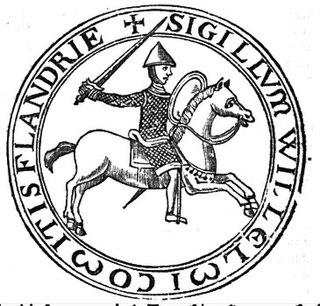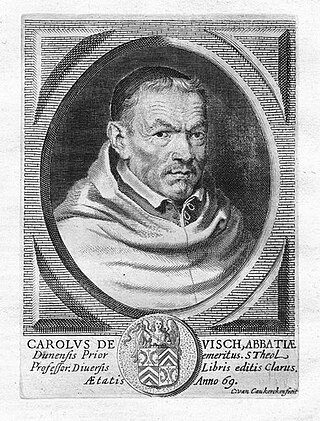
William Clito was a member of the House of Normandy who ruled the County of Flanders from 1127 until his death and unsuccessfully claimed the Duchy of Normandy. As the son of Robert Curthose, the eldest son of William the Conqueror, William Clito was seen as a candidate to succeed his uncle King Henry I of England. Henry viewed him as a rival, however, and William allied himself with King Louis VI of France. Louis installed him as the new count of Flanders upon the assassination of Charles the Good, but the Flemings soon revolted and William died in the struggle against another claimant to Flanders, Thierry of Alsace.

Joan, often called Joan of Constantinople, ruled as Countess of Flanders and Hainaut from 1205 until her death. She was the elder daughter of Baldwin IX, Count of Flanders and Hainaut, and Marie of Champagne.
Baldwin II was the second margrave of Flanders, ruling from 879 to 918. He was nicknamed the Bald (Calvus) after his maternal grandfather, Emperor Charles the Bald.

Arnulf I, called "the Great", was the first Count of Flanders.

Philip III the Good ruled as Duke of Burgundy from 1419 until his death in 1467. He was a member of a cadet line of the Valois dynasty, to which all 15th-century kings of France belonged. During his reign, the Burgundian State reached the apex of its prosperity and prestige, and became a leading centre of the arts.

Jacques de Vitry was a French canon regular who was a noted theologian and chronicler of his era. He was elected bishop of Acre in 1214 and made cardinal in 1229. His Historia Orientalis is an important source for the historiography of the Crusades.

The Battle of Honnecourt took place on 26 May 1642, during the 1635 to 1659 Franco-Spanish War. A Spanish army led by Francisco de Melo defeated and largely destroyed a French force under the Comte de Guiche.

Jacobus Pamelius was a Flemish theologian who was named bishop of Saint-Omer.
Jacques de Châtillon or James of Châtillon was Lord of Leuze, of Condé, of Carency, of Huquoy and of Aubigny, the son of Guy III, Count of Saint-Pol and Matilda of Brabant. He married Catherine of Condé and had issue.
Munderic was a Merovingian claimant to the Frankish throne. He was a wealthy nobleman and landowner with vast estates in the region around Vitry-le-Brûle near Châlons-sur-Marne.

Judith of Flanders was, by her successive marriages to Tostig Godwinson and Welf I, Countess of Northumbria and Duchess of Bavaria.

George Chamberlain or Chamberlayne (1576–1634) was an Englishman who became the sixth bishop of Ypres.

Ten Putte Abbey is a monastery with an abbey in Gistel, roughly 8 km to the south of Ostend, in the western part of Belgium. It was built to mark the spot where, in 1070, Saint Godelina was murdered by strangulation and then thrown into a pond. Before 2007 the abbey was home to nine Benedictine nuns, who were members of the wider Subiaco Cassinese Congregation in West Flanders. Since 2007 it has been occupied by brothers and sisters of the "Mother of Peace" community.

Ter Doest Abbey was a Cistercian abbey in Belgium, in the present Lissewege, a district of Bruges, West Flanders.

Ten Duinen Abbey or the Abbey of the Dunes was a Cistercian monastery at Koksijde in what is now Belgium. It was one of the richest and most influential religious institutions in the medieval County of Flanders. It later relocated from Koksijde to the city of Bruges.

Carolus or Karel de Visch (1596–1666) was a Cistercian bibliographer, and prior of Ten Duinen Abbey.
Adrianus Cancellier (1580–1623) was the 39th abbot of Dunes in the County of Flanders.
Nicolaes Breyghel, Latinized Nicolaus Breyghelius, was a leading printer and bookseller in 17th-century Bruges in the Habsburg Netherlands. He was the first publisher of a weekly newspaper in the city.

Jacobus van Eynde or van den Eynde was a Flemish organ builder.













